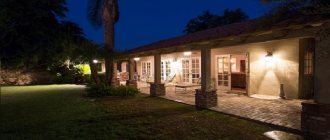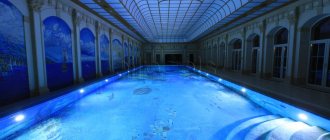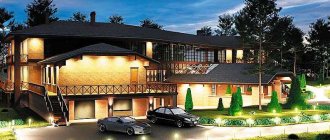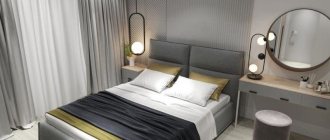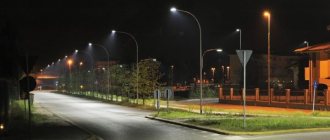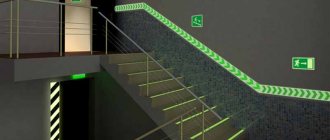Fixtures for facade lighting
The beam of light that needs to be directed onto individual elements of the façade can be created using a halogen or metal halide lamp with a lens or reflector.
With the help of such lighting you can create various interesting lighting effects. For these lamps, you can take any type of light bulb, which will allow you to play with light. As a rule, LED lamps have recently been used, as they save energy and have a long service life - up to 100,000 hours.
The latest know-how in lighting is lamps based on the “sandwich” principle, where there is silicone between the glass walls, and LEDs in the silicone. They are available in various colors, sizes and shapes, and can also be modified according to a given program.
You can also highlight the stairs that lead to the front door. When a person steps on the step, the light comes on.
You can also choose the lighting color. True, such lighting devices are expensive, but maybe soon they will become available to everyone. Moreover, facade LED lighting is very economical.
To illuminate the facade and the area outside, you need to take into account that the light bulbs must be moisture-resistant and dust-resistant. The housing for an outdoor lamp should be aluminum, as it is the most weather-resistant. Based on the manufacturing method, it is better to choose cast lamp housings.
Halogen or metal halide lamps are an excellent choice; they will last four times longer than conventional lamps and save up to 80% of energy. Also, such lamps illuminate the facade with natural bright light.
A house that is lit from bottom to top looks beautiful, and not vice versa. He will appear taller and more beautiful. It is also worth highlighting the house number and street name. Keep in mind that halogen lamps produce a beam of up to 3 meters, and metal halide lamps have a beam of up to 6 meters.
Types of facade lighting
There are 6 types of facade lighting. Which one to choose depends on the functions of the building, customer preferences, existing technical limitations, budget and landscape. Lighting techniques can be combined.
Dynamic
Dynamic backlighting is characterized by variability in color and brightness.
Types of lighting fixtures:
- Spotlights;
- LEDs;
- ribbons;
- spotlights.
Dynamic lighting is characterized by color changes.
Contour
In this case, it is assumed that light elements will be placed along the contour of the walls. It is convenient to use flexible neons and LEDs in the shape of different shapes.
The contour lighting concept began to be used relatively recently, so specialists often develop projects from scratch rather than using ready-made solutions
Correctly selected devices help highlight the outlines of the house, focus on corners, columns and other interesting elements.
Contour lighting outlines the outline of the building.
Local
Parts of the façade are illuminated separately.
Local light is used when you need to visually highlight part of the facade. Examples: lighting of windows, doors, cornices, balconies, foundations, basements.
Local lighting projects are used to visually highlight facades made of wood, porcelain stoneware and other materials.
Panel cladding with bright illumination also looks impressive. The main advantages of local lighting are efficiency and versatility.
Lamps are attached to the facade, located in the places provided for by the project. The brightness of the devices is low, the effect is achieved through proper layout.
An alternative option is neon ribbons. They consume less energy than older fluorescent ones.
Background fill
This type of lighting highlights outlines and elements (not necessarily along the edges), but leaves the main part dark. The fill is designed based on LED tubes. They are used to illuminate the facades of theaters, museums, palaces, and concert halls.
The main part of the building remains dark.
Illuminated facades
The sources are positioned so that the rays illuminate the facade from the inside.
Lighting design can be stationary or abundant, adjustable in brightness and color.
Objects for which this façade lighting concept is suitable:
- offices;
- shopping and entertainment centers;
- the shops;
- night clubs.
Lighting is provided from inside the façade.
Flooding
Used to illuminate cultural property.
This type of lighting is suitable for optical highlighting of buildings, sculptures, structures of historical, cultural, artistic or architectural value.
These include monuments, sculptures, monuments, steles, and temples.
Spotlights are placed on the ground or elevated surface and direct the beams so that they shine on the object from different directions.
The light composition is bright, but it has a limitation. Flood structures should not be installed where they will enter windows and create discomfort for people living in nearby buildings or working in nearby areas.
Contour lighting
This lighting outlines only the outline of the building, emphasizing its main architectural elements:
- roof line
- angles
- arches
- bay windows and balconies
In this case, the building itself will look dark and its details will be hidden in twilight. In fact, a building takes on a completely different look at night, and it can be even more attractive than during the day.
For this lighting, LED strips and garlands are often used.
Not a single New Year is complete without contour lighting. In action:
- neon lights
- colored LED garlands
Differences and similarities between dynamic and static backlighting
The differences between the two types of lighting lie not only in the scope of application and intended purpose, but also in the types of equipment used. At objects that require static lighting, both LED spotlights and lamps, as well as devices that work with other types of light sources, for example, gas-discharge lamps, are successfully used.
The most profitable from an economic and practical point of view is the use of LED devices. Sufficient brightness and low power consumption allow this type of device to be used in both cases. Modern LED equipment allows you to fine-tune all lighting parameters from beam brightness to color saturation.
The advantages of LED devices include the following:
- Significantly lower energy consumption compared to incandescent lamps and gas-discharge lamps;
- The absence of harmful gases that can have a detrimental effect on the human body and the environment if the lamp bulb is damaged;
- Higher efficiency ratio, expressed in the ratio of electricity consumed and light generated;
- The versatility of the devices and the ability to use them in various conditions;
- High degree of protection against mechanical, chemical and other types of influence.
In general, LED equipment is the universal factor that combines static and dynamic types of lighting. There are types of devices that are amenable to hardware configuration and are capable of operating in various modes, providing, if necessary, static or dynamic illumination of the building facade.
Other applications of the two types of backlight
In addition to the design of facades, these two types of lighting can be used for technical and interior lighting. Spotlights and lamps are widely used in the advertising business, for illuminating banners and stands.
Pulsating dynamic lighting is used in airport buildings and on highways. Here you can also see multi-colored static lighting used to delimit safety zones and mark potential threats to traffic.
Diode lamps are used to illuminate the facades of swimming pools, sports grounds, the interior of clubs, restaurants and other public places that require the use of high-quality lighting technology.
LIGHTING CALCULATION
An architectural lighting model is created using modern lighting calculations in a special program. Lighting fixtures for future architectural lighting are placed according to a given pattern in a small copy of the building, even if the template is drawn in Photoshop. Based on the model, it is easier to comply with the specified lighting standards, its type, power, and also check the location of each light source. The program will show on the laptop monitor unexpected errors in the location of the backlight, stray light, unaccounted shading, and will itself calculate the angle of light dispersion, taking into account the optical parameters of the lamps, reflecting the properties of the walls, and the architecture of the house. The program's artificial intelligence compresses project deadlines and minimizes any errors.
At the end, the lighting calculation program will display all the indicators of architectural lighting and will most clearly draw the layout of spotlights and lamps for external lighting. The engineer will receive the correct dimensions of consumables and components for installing architectural lighting. The customer will be provided with all the necessary documents, including the “Detailed lighting design” and “Detailed electrical design”, as well as an estimate for architectural lighting of buildings or industrial facilities.
Selecting luminaires and lighting control methods
The choice of types of lamps depends on the type and purpose of the illuminated room. When designing complex lighting installations, such as large office buildings, luminaires and switch locations are usually chosen by designers and architects. Then the designers, in close cooperation with lighting equipment suppliers, carry out illumination calculations for all rooms and arrange the fixtures. When designing lighting for ordinary rooms, the designer performs all the work himself. Preference is given primarily to lamps with maximum luminous efficiency and service life. But it is necessary to take into account the characteristics of the emission spectra of lamps, taking into account their effect on the human body. When choosing lamps, you should take into account the color rendering index, the coefficient of pulsation of illumination, as well as indicators of glare and discomfort. Descriptions of many types of the most widely used lighting fixtures are given in the “Light Fixtures” section.
Selecting lighting control methods. To turn on lamps in small rooms, as a rule, switches are installed indoors on the side of the door handle. In large rooms it is more convenient to control lighting from one place. If there is a security post, then the lighting is controlled from this post. In long corridors, it is convenient to install switches at both ends of the corridor, which allow you to control lighting from two or more places.
At high powers of group lighting lines, magnetic starters (contactors) are used to turn on the lamps, the control coils of which are switched either by conventional switches or using a push-button station. The push-button post contains two separate buttons for turning the lighting on and off. When the lighting is working, the on state of the magnetic starter is ensured by its self-locking.
In bathrooms, showers and bathrooms, switches are installed outside these rooms.
Choosing the location of devices
The placement of lighting equipment is as important a component as the choice of devices. When performing this stage, the designer must analyze both the parameters of the lighting fixtures (type, power) and the features of the structure. TO
As a rule, devices for flood lighting are mounted on separate supports or on objects located nearby. Also, a popular solution is to install devices on special brackets mounted directly on the structure.
Local lighting is often located near the element that it highlights. For large element sizes, the device can be placed on a support, the role of which is played by a protruding part, for example, a loggia.
The general rules for placing architectural and artistic lighting are as follows:
- it is necessary to ensure ease of installation of devices and their maintenance in the future;
- it is necessary to provide the technical possibility of connecting power supplies to the devices;
- a guarantee is required that the lighting equipment will be absolutely safe for people inside and outside the building.
Basic rules for designing architectural lighting
Before creating a facade lighting project, it is necessary to decide what type of lighting to use in order to create the safest and most comfortable conditions for movement around the site and near the house at night, and at the same time, everything is arranged so that the light does not interfere with rest. It is imperative to choose a type of lighting fixture that would effectively perform its task and at the same time serve as a unique decoration for the home.
If you use light correctly, the exterior can be endowed with notes of modernity, the Middle Ages, etc. To improve the lighting effect of the facade, you can place several spotlights around the country house so that their light evenly illuminates the building. An equally effective option is when light elements are installed pointwise on the facade in such a way that their rays beautifully highlight the architectural elements of the building.
An important detail: not every type of lighting can be used to design architectural lighting for the facades of buildings outside the city. The arrangement of flood lighting is considered unacceptable - private houses are usually low, and this option is intended for high-rise buildings. In addition, flood light will enter the windows, so all rooms will be very bright at night, which can make it difficult to sleep at night.
Designers strongly recommend using down-light lighting devices to illuminate the facade of a cottage, as they have important advantages: the devices are compact, but have the same power as small spotlights, and they can also change the angle of the lamps to more effectively obtain light spots
Equally interesting for creating decorative lighting for building facades are devices with halogen directional light lamps. Their use has the following advantages:
- In devices of this type, the direction of the beam and the radius of illumination are adjustable.
- The devices are compact, so they do not take up much space.
- The operation of lamps allows you to save money - LED lighting of the facade of the house consumes very little energy.
- Efficiency. When using devices of this type, the flood of light can be made powerful and uniform.
Overhead lighting fixtures look especially advantageous on building facades. Such lamps can be combined with strobes, bollards, and colored illumination. To illuminate the area in front of the building, you can install decorative lanterns and special lighting devices on supports.
Not only the lighting of the facade of the house requires attention, but also the porch. It is best to equip the space near the front door with lamps that diffuse light. Thanks to the reflectors, the light will be evenly dispersed throughout the space closest to the house. If you are arranging not only lighting for the facade of a private house, but also the landscape around it, it is necessary to create the entire composition in the same style. Only this approach guarantees a beautiful and harmonious design of the site as a whole.
Before creating an architectural lighting project, you need to make sure that it is economical and easy to use. To do this, you need to divide the object into the following zones:
- Entrance. Both the main and side entrances, if any, are taken into account.
- Secondary areas that also need to be illuminated.
WORKING LIGHTING PROJECT
Your working lighting project will include a description of the architectural lighting project with output data, an accompanying note, and a list of working kit drawings. In addition, you will receive a list of documents with links, a complete list of survey data of the premises or building, as well as a general plan, a diagram of the building facades and a photo illustration of the actual position of the building or architectural monument. ;
The lighting project will include a task to develop mounting points for lamps, as well as visualization of lighting and possible solutions for illuminating the house at night: economical, festive or everyday modes of architectural lighting according to the terms of reference. A well-developed diagram of the location of light sources on the external walls of the building will be provided in two forms: in the form of a plan and in sections of the object. It includes lighting engineering calculations of building facades, features of lighting equipment, binding of spotlights and lamps, annotation to the equipment, and a targeting diagram (if necessary).
The filling of the “Working Electrical Project” is carried out according to the same principle. It contains a description of the project with general data and an explanatory note. If necessary, a geo-base can be included in the detailed electrical design for architectural lighting.
In the same project: a plan for the placement of lighting elements at the ends of the house and its plans, schematic diagrams of the external power supply network, power supply network diagrams, control drawings for lighting installations. Separately, the designer will provide a plan for the arrangement of electrical equipment and the laying of electrical cables for each floor. It will include a diagram of electrical routes, symbols, a cable log and a list of specifications of products, components and equipment used.
How to implement artistic lighting
It can be implemented in several ways:
general light fill With its help you can illuminate a separate building among the total mass;
local illumination The goal is to highlight several architectural fragments
Please note: if there are repeating parts, their lighting will give special expressiveness;
contour lighting It allows you to indicate the silhouette of a building using light. The building can be illuminated as a whole or in separate fragments
This way you can draw attention to columns, spiers and other elements;
background illumination The goal is a special background of the building due to color. The backlight can be made movable and create an amazing play of light and shadows;
various projections This refers to various images that are usually projected on the facade and can move;
hidden lighting Designed for lighting stairs, lighting bridges, fountains;
combined lighting Involves the use of several types of lighting at once;
media façade is a type of façade illumination designed to change the color and intensity of the illumination. Controlled by a computer system.
Architectural lighting of a residential complex
Basic techniques of architectural lighting
Before we begin to consider the different types of lamps that can be used to organize a lighting system, it is necessary to understand what types of architectural lighting there are. Depending on the type of object and the desired result, there are 7 lighting methods:
General or flood – used when it is necessary to highlight a separate object or structure, including large cultural monuments, churches or cathedrals. Russian Orthodox Church including.
This type of lighting can be realized using RGB, white and amber spotlights for artistic lighting of buildings. The method allows you to fully convey the significance and scale of the object, as well as ensure its holistic perception. The entire object and some part of the surrounding area are illuminated. However, it is necessary to understand that with flood lighting, spotlights are installed directly in front of the building, at some distance from it, or on poles and directed towards the facade. Therefore, some of the rather bright light will constantly appear through its windows, which can cause significant discomfort. Because of this, it is not recommended to choose a similar lighting system for buildings where people are constantly present, for example, for hotels or large office centers;
Local lighting – used to highlight any individual element or small area. This could be, for example, a beautiful cornice or balcony, a frieze, an unusually shaped window opening or a vault
This technique is designed to draw attention to spectacular details that may otherwise go unnoticed. To implement such lighting, wall lamps of small size and low power are most often used, which are mounted directly near the illuminated object.
Linear LED lamps can also be used, which are significantly smaller in size than conventional fluorescent lamps;
Background or silhouette lighting is implemented using powerful flood-type spotlights, which are installed in front of the object at a certain angle. Their task is to create a luminous background, which will become an advantageous basis for effectively and clearly highlighting the contours of the facade. Most often, this type of lighting is used when it is necessary to emphasize the grandeur and beauty of various castles or theaters, buildings with columns. Contours become clear, graphic and pronounced;
Contour lighting – implemented using linear LED lamps. From the name it is clear that lighting fixtures are installed along the contours of a particular object and favorably emphasize non-standard silhouettes;
The “light façade” system is used to illuminate modern multi-story business or shopping centers. In principle, it can be used for any objects whose facades are made of plastic or glass. The difference between this system is that the lighting fixtures are installed behind glass, and their luminous flux is directed onto the window opening in such a way that a static or dynamic effect is created. The lamps themselves can be either monochrome or RGB;
Color-dynamic lighting is implemented using controllable spotlights, LED strips, spotlights and other lamps. This lighting system can be used in all of the above types, that is, it can be both flood and contour, etc. Its difference lies in the fact that controllable lamps can operate in different modes - with smooth fading and increasing brightness, with changing the color spectrum and color synthesis, which allows you to achieve amazing effects. Such lighting is widely used to create special fountain designs;
Illumination in the form of color graphics is also created using controllable lamps that can change the color of the glow depending on the applied brightness. By adjusting this parameter, interesting color patterns are created on building facades, which can consist of either solid luminous lines or individual dots.
Architectural lighting of building facades
The architectural design of any building is not limited to its appearance, which can be observed during the day.
With the onset of darkness, any architectural object is transformed with the help of LED building lighting. Such illumination not only gives new life to buildings at night, but also incredibly transforms the city, making it attractive, lively and bright. Of course, the most popular (since affordable) type of street lighting is the use of street lamps, but this is more of a necessity than an aesthetic need. Architectural lighting of building facades is a powerful, modern tool in the hands of architectural engineers and designers that can give new life to any commercial or residential building, revealing its full external potential. For the average person, performing such work on installing night lighting will seem like a simple and low-cost task, but this is not so. What ordinary people are used to seeing around is the work of a team of professionals, the interaction of new installation technologies and lighting modeling programs, and can only be developed by experienced designers.
Architectural lighting of buildings
beneficial for emphasizing your status and maintaining the image of successful and reliable partners. A company that cares about the quality of its services and the aesthetic appearance of the building will earn more trust and sympathy from others, and will look brighter and more competitive in the market. This approach to work is very relevant at times such as New Year and Christmas, when shopping centers are illuminated for the New Year, as well as Victory Day, the city, Russia, etc. is already an integral part of the festive life of any city.
A distinctive feature of the Garant Media company is the breadth of the range of services offered for installation and development of architectural lighting
. Depending on the features of the facade, the company’s specialists will offer the most optimal illumination option for the building, taking into account all the wishes and suggestions of the customer, the budget and, of course, the architectural uniqueness of the building, which must be emphasized and highlighted.
Types of architectural lighting
General façade lighting
Lighting devices are mounted in such a way as to provide illumination of the main elements of the object. General architectural lighting and building lighting are used to create a specific urban style, drawing attention to individual buildings. By manipulating the degree of illumination, you can differentiate them by status and rank. For example, state, municipal, district, etc.
Flooding Light
LED lighting of building facades using medium-power lamps can convey the monumentality of a composition, combining various elements into a single whole. More often it is ordered for the design of historical, cultural and non-residential objects: monuments, temples, churches, etc. Directional spotlights are mounted on the ground or on small supports.
Hidden lighting
Sets of small-sized lighting devices are used when it is necessary to discreetly create a unique look or emphasize the decorative details of a building. A good option is overhead LED spotlights of medium power or other compact lamps with small dispersion angles. The combination of different shades allows you to create a mesmerizing light aura around protruding cornices, balconies, columns or other volumetric structural elements.
Contour lighting
Installing lamps along the contour allows you to effectively highlight the silhouette of the building against the background of a dark space. In this case, it is possible to emphasize not only the outer edges of the object, but also the configurations of specific structural elements. To design contour-type architectural lighting, linear LED lamps, strips and neon tubes are in demand.
Decorative lighting
A suitable way to create an original look using certain elements of the building's architecture
By highlighting specific details, designers focus attention on the attractive aspects of the design, hiding, if necessary, less refined aspects. Various types of lamps are used for decorative lighting
However, the most practical and economical are LED devices.
Dynamic lighting
The attractiveness of such illumination lies in its mesmerizing spectacle. You can buy dynamic LED lighting for advertising purposes, on New Year's Eve or other major holiday. The use of various lamps makes it possible to create drawings, figures, animations, and other lighting effects with control of shades, shapes, brightness and other parameters.
Results of studies on the effectiveness of architectural lighting
The number of buildings with illuminated facades is increasing sharply. Lighting design must meet the requirements of new architectural, social and technological trends. Saving energy is a global challenge, so façade lighting must be environmentally friendly. At the same time, any lighting entails an increase in energy costs. Light directed inappropriately onto the façade is perceived as an irritant and a waste of money. When developing a façade lighting project, we strive to optimize architectural lighting solutions in urban environments. The ultimate design goal is to create the most efficient and high-quality outdoor lighting.
- The effectiveness of shops and commercial enterprises depends on how well the lighting around them is done
- Visually attractive cities are more desirable places to live
Kinds
All existing varieties of such devices can be divided into flood light devices, local and hidden lighting.
- Spotlights are halogen or LED models with a bright and directional light output. Depending on the type of location, they can be panoramic or angular.
- Built-in varieties include wall sconces in the form of lanterns.
- Floor lamps belong to the class of double-sided lamps. These sconces are functional and suitable for lighting entrance areas, adjacent areas, as well as signage signs. They can be used to fill the main space with light, to design a veranda or terrace, or to illuminate small areas of the facade.
In addition to these varieties, linear or tape-type products are popular options. These are special diode LED lamps in the form of a flexible strip. LED strip lighting allows you to identify architectural elements, highlight the contours of the roof, and create an interesting pattern. It can be hidden behind the cornice, stucco molding, and elements of the entrance group.
Ground varieties are fixed near the building. More often the base is a concrete base, tiles or asphalt. Such models are protected from moisture and accidental mechanical damage. During installation, you can give them the desired angle of inclination of the light flux. This allows you to create a special light composition. Lighting sources can have different shapes (from retro and classic models of lamps to ultra-modern new products or products in the form of figures, as well as overhead analogues).

